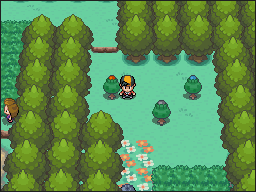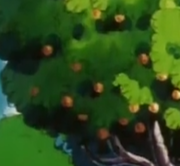Apricorn
- If you were looking for the crafting material in Pokémon Legends: Arceus, see Apricorn (item).
Apricorns (Japanese: ぼんぐりのみ Bonguri Fruit) are fruits that can be used to construct Poké Balls. They grow in the Johto, KantoHGSS, and Hisui regions, and on Galar's Isle of Armor.
Apricorns can be hollowed out and fitted with special devices to function as Poké Balls. This process was developed sometime between 400 and 700 years before the present day (between the burning of Brass Tower and the first Orange League competitions). Before Poké Balls became standardized, everyone used Poké Balls made in the traditional way. In the Hisui region, people craft Poké Balls using Brown Apricorns and Tumblestones. In the modern day, only specialists (such as Kurt) can make Poké Balls from Apricorns.
Because the outer skin of Apricorns are so tough, they cannot be eaten by Pokémon unprocessed. In the wild, Pokémon wait for them to turn into Spoiled Apricorns and eat through the softened skin to the insides. Trainers can blend Apricorns in an Apriblender to make Aprijuice for their Pokémon to drink.
List of Apricorns
| Name | Corresponding Poké Ball |
Corresponding performance stat(s) | ||
|---|---|---|---|---|
| Black Apricorn | Heavy Ball | All | ||
| Blue Apricorn | Lure Ball | Jump | ||
| Green Apricorn | Friend Ball | Skill | ||
| Pink Apricorn | Love Ball | Speed | ||
| Red Apricorn | Level Ball | Power | ||
| White Apricorn | Fast Ball | None | ||
| Yellow Apricorn | Moon Ball | Stamina | ||
In the core series games
Mechanics
Apricorns can be turned into Apricorn Poké Balls. In Pokémon Gold, Silver, Crystal, HeartGold, and SoulSilver, the player can give Apricorns to Kurt in Azalea Town, who will have turned them into Poké Balls by the next day. In Gold and Silver, he can only craft one Poké Ball at a time, whereas in subsequent games he can craft any number of the same Poké Ball at once.
Additionally, in HeartGold and SoulSilver, they can be blended using an Apriblender to make drinks which improve a Pokémon's performance for Pokéathlon competitions. The color of the Apricorns corresponds to their flavor and associated performance stat, with the White and Black Apricorns affecting all stats.
In HeartGold and SoulSilver only, Apricorns cannot be held, in order to prevent them being traded to Pokémon Diamond, Pearl, and Platinum (where they do not exist). In these games, Apricorns are placed in the Apricorn Box (a Key Item that functions like a pocket) instead of the Bag's Items pocket. However, a Pokémon caught in an Apricorn Poké Ball can be traded to Diamond, Pearl or Platinum, although the Pokémon's Poké Ball will appear as a standard Poké Ball in those games.
In the Pokémon Sword and Shield Expansion Pass, the player can find and use Apricorns on the Isle of Armor. Inside Mustard's room in the Master Dojo, the player can find the Cram-o-matic, a robot resembling a Cramorant, made by Mustard's son Hyde. It can be fed four Apricorns to create a random Poké Ball, which is determined by the combination of Apricorns put in.
In Pokémon Legends: Arceus, with the game taking place in the past, all Poké Balls are crafted from Brown Apricorns (simply referred to as Apricorns in the game). Variant Poké Balls can be constructed by using additional or alternative materials, but all Poké Balls use a Brown Apricorn.
Acquisition

The primary method of obtaining Apricorns is from Apricorn trees. These trees yield one Apricorn per day. In the Generation II games, only one of each Apricorn is available per day, from the Apricorn trees on Routes 37 and 42 and in Azalea Town.
In HeartGold and SoulSilver, Apricorns are much more widely available. Locations that contained Berry trees in Generation II now contain Apricorn trees instead, sometimes with the number of trees also being increased. Green Apricorns are by far the most common, appearing in eight places; while White and Red Apricorns are the least common, each only appearing in three places.
In The Isle of Armor, Apricorns are obtained by shaking Berry trees across the island or by exchanging Watts.
In Legends: Arceus, Brown Apricorns can be found growing on trees throughout the Hisui region. These Apricorns can be retrieved by having a Pokémon bump the tree they grow in. The Apricorns regrow quickly, once the player has left the vicinity.
In the spin-off games
Pokémon Quest
An Apricorn is an ingredient that can be used in cooking to attract wild Pokémon in Pokémon Quest.
Description
|
Acquisition
Apricorn is a possible ingredient that can be obtained by completing expeditions. It can also be obtained randomly by recycling Power Stones.
In animation
Pokémon the Series
Pokémon the Series: Gold and Silver
Apricorns made their only major animated series appearance in Going Apricorn!. After Kurt had given Ash, Misty, and Brock a Fast Ball each, made from White Apricorns growing next to his house, he sent them to collect other Apricorns with Maizie. After several failed attempts at picking Apricorns, the group managed to pick two Blue Apricorns and a Black Apricorn, which Kurt used to make a pair of Lure Balls and a Heavy Ball for them, which they obtained shortly before leaving Azalea Town in the next episode.
Pokémon the Series: Diamond and Pearl
In An Egg Scramble!, Yellow Apricorns were one of the things Khoury was selling at the Johto Festival.
Gallery
Pokémon Horizons: The Series
In Found You, Fuecoco!, Apricorns were mentioned in one of Nidothing's videos.
In the manga

Pokémon Adventures
Gold, Silver & Crystal arc
Apricorns were first seen in Teddiursa's Picnic, where Kurt's ability to turn them into special Poké Balls was demonstrated. Gold, unaware of Apricorns' true purpose, attempted and failed to eat one from a tree.
In Yikes, It's Yanma!, an Apricorn lottery was used to randomly decide which pairs of Gym Leaders from Kanto and Johto would face each other in an interregional exhibition tournament at Indigo Plateau. Erika and Pryce, due to their statuses as the leaders of their respective regions' Gym Leaders, were automatically selected to battle each other.
HeartGold & SoulSilver arc
In Out-Odding Oddish, Gold was seen running around the Pokéathlon Dome to make Aprijuice out of Apricorns with his Apriblender.
Gallery
Trivia
- In Pokémon HeartGold and SoulSilver, Apricorns have different sprites for the Apricorn Case and the Bag. In these games, the Bag sprites are only used in the point-exchange menu at the Pokéathlon Dome.
- Because of the length of the word "Apricorn", only the Red Apricorn is able to have its full color name in English prior to Generation VI, with the other six having abbreviated versions because item names are limited to 12 characters (including spaces). Starting in Generation VI, item names can be longer, and the Apricorns are all spelled out in full in English (although they were not made available until Generation VIII). In all generations in Japanese, abbreviation is used only for the Green Apricorn, which uses みど mido as an abbreviated form of みどり midori, green.
- In Generation IV, if an Apricorn tree is left bare and on-screen without turning the game off over midnight, the plant will sparkle (in the same way Berry plants do when advancing a stage) and an Apricorn will appear on it. If the game was in sleep mode (the Nintendo DS was closed) over midnight, this will happen as soon as the game is taken out of sleep mode.
Name origin
The word Apricorn may be a combination of "apricot" and "acorn".
Bonguri may come from ぼんたん bontan (pomelo) and どんぐり donguri (acorn).
In other languages
| ||||||||||||||||||||||||||||||||||||||||||||||||||||||
See also
| Types of items | |
|---|---|
| General | Evolution stones • Fossils • Flutes • Shards • Held items Evolution items • Escape items • Exchangeable items • Valuable items Battle items • Scents • Nectars • Candy • Ingredients |
| Medicine | Status condition healing items • Vitamins • Feathers Mints • Mochi • Drinks • Herbal medicine |
| Berry and Apricorn | Poké Balls • Apricorns • Berries • Mulch |
| Aesthetic | Decorations • Accessories • Backdrops • Props • Décor Clothing (XY • SMUSUM • LGPE • SwSh • BDSP • LA • SV) |
| Other | Mail • Key Items • Event items Wonder Launcher items • Rotom Powers |
| This item article is part of Project ItemDex, a Bulbapedia project that aims to write comprehensive articles on all items. |












